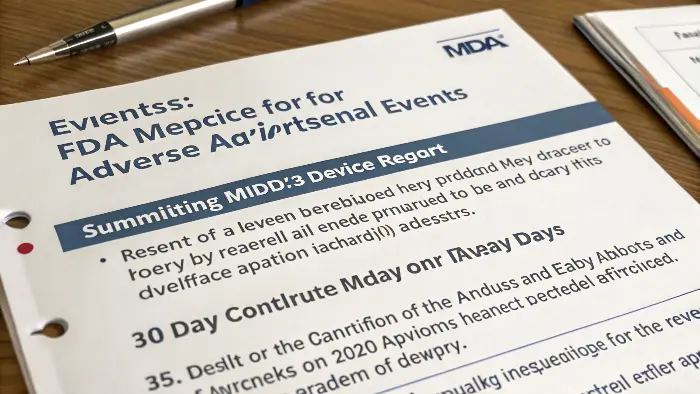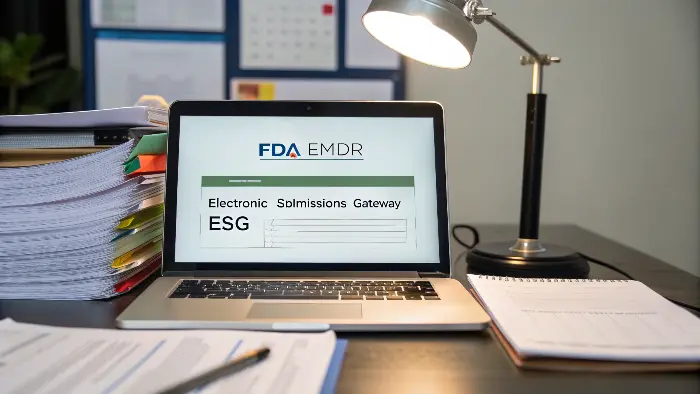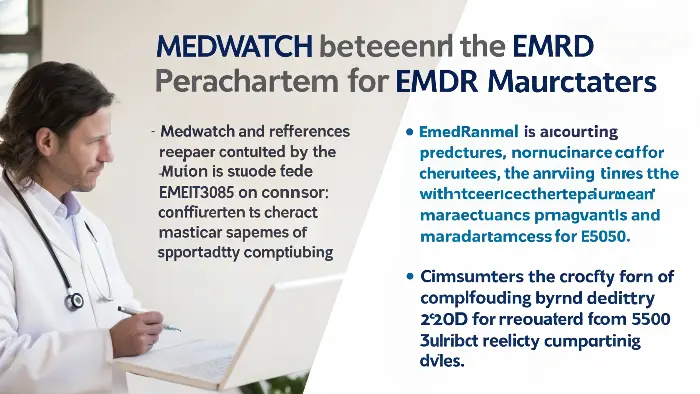Are you worried about a customer reporting an issue with one of your products? A single adverse event can attract regulatory scrutiny and harm your brand’s reputation if you’re not prepared. This uncertainty creates risk and stress you don’t need. Building a compliant system is the solution that protects your business.
To build a compliant Adverse Event Reporting System (AERS), you must first understand the regulatory requirements in your target market, like those from the FDA in the US. Then, create clear internal procedures to collect customer complaints, evaluate them against official reporting criteria, and submit them to the correct authorities within the specified deadlines. Meticulous documentation is essential. This framework ensures you meet legal obligations and maintain product safety standards.

It all sounds very technical, but I’ve learned that breaking it down makes the entire process manageable. For me, creating a solid reporting system became more than just a regulatory task. It’s a fundamental part of being a responsible brand owner who cares about customer safety. It proves to your partners and customers that you are serious about quality. Let’s dig into the specific details you need to set up a system that works.
What Are the Four Key Criteria for an Adverse Event Report?
Are you ever confused about when a customer complaint becomes a formal, reportable event? Making the wrong judgment call can easily lead to non-compliance, even with the best intentions. This uncertainty adds risk to your business that you can easily avoid. Let’s clarify the exact triggers for a mandatory report.
A reportable adverse event generally requires four key pieces of information. First, an identifiable patient. Second, an identifiable reporter. Third, a specific suspect product (your device). And fourth, a specific adverse event or negative health outcome. If you receive these four details, the clock officially starts ticking on your reporting timeline.

When my team and I first started formalizing our process, we focused heavily on these four pillars. Knowing them removes the guesswork. You either have the required information to make an evaluation, or you don’t. This clarity is crucial when you’re under pressure. Let’s break down each one so you can build them into your own customer service and quality assurance procedures.
The Identifiable Patient
This criterion is about associating the event with a specific person. It doesn’t necessarily mean you need their full name and address. The FDA considers a patient "identifiable" with any unique detail, such as an email address, initials, date of birth, or a customer ID number from your sales system. As a manufacturer, the key is that you can distinguish this person from any other. If someone contacts you and says, "A friend of mine had an issue," that is not an identifiable patient until that friend provides some personal detail. Your internal complaint form should have a clear section for capturing this information right away.
The Identifiable Reporter
You also need to know who is making the report. This person is your source of information. The reporter can be the patient themselves, but it could also be a healthcare professional like a doctor or nurse. It might even be a concerned partner, a family member, or a lawyer representing the patient. The important thing is that you have contact information for the person who brought the issue to your attention. This allows you to follow up if you need more details to complete your investigation. We train our support team to always get a name and a contact method (email or phone) for the person reporting the issue.
The Suspect Product
This one seems obvious, but it requires precision. You must be able to link the adverse event to a specific product you manufacture or sell. This is why having clear product names, model numbers, SKUs, and batch or lot numbers is so important. If a customer says, "Your vibrator caused a rash," you need to ask clarifying questions to identify the exact product. Was it the "Serene Wave" or the "Pulse Pro"? What color was it? Can they find a lot number on the packaging? Documenting this accurately is essential for tracking potential issues back to a specific production run.
The Adverse Event
This is the core of the report: what actually happened? An adverse event is any undesirable experience associated with the use of the product. For our industry, this could include:
- A severe skin irritation or allergic reaction to a material.
- A malfunction causing a burn, cut, or electric shock.
- An infection resulting from use or difficulty in cleaning the product.
- The product breaking during use and causing an internal injury.
The event must be a specific outcome. A vague complaint like "I didn’t like the product" is not an adverse event. But "The product’s motor overheated and burned my skin" is a clear and specific adverse event.
| Criteria | What It Means | Example |
|---|---|---|
| Identifiable Patient | A specific individual can be identified. | Customer Jane Doe, Order #12345 |
| Identifiable Reporter | The person making the report can be identified and contacted. | Jane Doe herself, or her doctor, Dr. Smith. |
| Suspect Product | The specific product is identified. | PrivyPlay "Pulse Pro", Lot #67890 |
| Adverse Event | A specific negative health outcome or problem occurred. | "Product overheated, causing a second-degree burn." |
What Are the FDA’s Specific Guidelines for Reporting Adverse Events?
Knowing an event is reportable is step one. Knowing exactly how and when to report it to the FDA is a completely different challenge. Missing a deadline or filing the wrong information can cause major compliance headaches and attract unwanted attention. Let’s break down the FDA’s exact rules to keep your brand safe.
The FDA requires manufacturers to submit a Medical Device Report (MDR) for certain issues. You must report within 30 days if your product may have caused or contributed to a death or serious injury. A malfunction that would likely cause harm if it recurred is also reportable within 30 days. For critical events requiring immediate action, a 5-day report is necessary.

These timelines are not suggestions; they are legal requirements. The 30-day clock starts from the moment your company’s employees (any of them!) become aware of a reportable event. This is why having a streamlined internal process to get information from your customer service team to your quality or regulatory person is so critical. There is no time to waste.
The 30-Day MDR for Death or Serious Injury
This is the most common type of mandatory report. If you become aware of information that reasonably suggests one of your devices may have caused or contributed to a death or serious injury, you must submit an MDR. A "serious injury" is clearly defined by the FDA. It means an injury or illness that is life-threatening, results in permanent impairment of a body function or permanent damage to a body structure, or requires medical or surgical intervention to prevent one of those outcomes.
For an adult toy, a serious injury could be a severe electrical burn requiring hospitalization or a product breakage leading to an internal laceration that needs surgery. A mild skin rash that resolves on its own would likely not meet the "serious injury" threshold, but a severe chemical burn from a material would. My rule of thumb is this: if the customer needed to see a doctor or go to a hospital, you need to evaluate it for a serious injury report.
The 30-Day MDR for Reportable Malfunctions
You also have to file an MDR within 30 days if your device malfunctions, and that type of malfunction would be likely to cause or contribute to a death or serious injury if it were to recur. Importantly, no one has to be hurt for this to be reportable. The potential for harm is what matters.
For example, imagine a waterproof, rechargeable vibrator. If you receive a report that the charging port’s seal failed and allowed water inside, short-circuiting the battery, that is a reportable malfunction. Even if the customer just threw it away and wasn’t hurt, that failure could cause a serious electrical shock or burn if it happened to another user in the bath or shower. You must report this type of event.
The 5-Day Report
This is for very urgent situations. A 5-day report is required if the FDA has made a written request for one or if a reportable event necessitates remedial action to prevent an unreasonable risk of substantial public harm. This is rarer for our industry, but not impossible. An example might be discovering that a whole batch of products was made with a toxic, contaminated material that you need to recall immediately. These situations are critical, and the report must be sent to the FDA no later than 5 work days after you become aware of the event.
| Event Type | Reporting Timeline | Key Trigger |
|---|---|---|
| Death or Serious Injury | 30 Calendar Days | Your product may have caused or contributed to the outcome. |
| Reportable Malfunction | 30 Calendar Days | A malfunction occurred that could cause serious harm if it happened again. |
| Urgent Remedial Action / FDA Request | 5 Work Days | An event requires immediate action to protect the public. |
Which FDA Platform Is Used for Submitting Adverse Event Reports?
You have all the information and you know your deadline. But where do you actually go to submit the report? Fumbling through confusing government websites is frustrating and wastes valuable time. You need to know the exact platform and be ready to use it without any delay.
The main platform for submitting Medical Device Reports (MDRs) is the FDA’s eMDR (Electronic Medical Device Reporting) system. Manufacturers are generally required to file reports electronically through the FDA’s Electronic Submissions Gateway (ESG). You will use the information fields found on Form 3500A to structure the report content for this electronic submission.

I cannot stress this enough: do not wait until you have an active report to figure this system out. The setup process itself takes time. Getting your company registered and ready to submit through the ESG should be part of your initial business setup, just like getting your manufacturer registration. Think of it as essential infrastructure for a compliant brand.
Understanding the eMDR System
The eMDR system is the FDA’s required method for manufacturers to submit MDRs. This isn’t like filling out a simple web form. It is a machine-to-machine transmission system that requires a digital certificate and a special account with the FDA’s Electronic Submissions Gateway (ESG). Applying for and setting up this account can take several weeks. If you wait until you have a 30-day reporting deadline, you will already be behind schedule. My advice is to begin this process the moment you decide to sell in the US market.
What is on FDA Form 3500A?
While you submit electronically, the data you provide is structured according to the fields on the Manufacturer and User Facility Device Experience (MAUDE) Form 3500A. Knowing these fields in advance helps you create an internal complaint form that captures all the necessary information from the start. Key sections include:
- Patient Information: Anonymized data like age, gender, and weight.
- Adverse Event and Outcome: A description of what happened and the health consequences.
- Suspect Device Information: Your product name, model, serial/lot numbers, and your FDA registration number.
- Manufacturer Information: Your company’s name, address, and contact details.
- Report Narrative: A detailed section where you describe the event, the results of your investigation, and any corrective actions taken.
The Submission Process Is Technical
Once you have your ESG account, the process is still technical. You cannot just upload a PDF of the form. The report must be formatted in a specific electronic file type called HL7 Individual Case Safety Report (ICSR). Most companies use specialized software or a third-party regulatory consultant to create these files. The basic steps are:
- Establish your ESG account and get your digital certificate.
- Gather all the required information for the report (based on Form 3500A).
- Use software or a service to create the report in the correct HL7 electronic format.
- Transmit the file to the FDA through the ESG.
- Receive and save the electronic acknowledgment from the FDA as proof of submission.
It’s a complex process, so investing in the right tools or a good consultant from the beginning will save you immense stress later.
Is MedWatch Reporting Mandatory for Manufacturers?
You see the MedWatch logo on drug ads and hear about "voluntary reporting." This can be very confusing. Do you, as a manufacturer, use the same system that consumers do? Using the wrong reporting channel can cause delays and signal to regulators that you don’t fully understand your obligations.
No, MedWatch reporting is not the mandatory system for manufacturers. MedWatch, which uses Form 3500, is the FDA’s voluntary reporting program designed for consumers and healthcare professionals. As a manufacturer, you have a mandatory obligation to report using the eMDR system and the data fields of Form 3500A. Confusing these two is a common but serious error.

This distinction is one of the most important things to understand about the U.S. reporting landscape. While MedWatch is a valuable source of safety information for the FDA, it is not your compliance channel. Your legal duty is separate and more stringent. Relying on your customer to submit a MedWatch report does not fulfill your legal requirement as a manufacturer.
MedWatch vs. eMDR: The Key Difference
Thinking of them as two separate roads to the FDA can help. One is a public road open to anyone, and the other is a commercial-grade highway with specific rules for industry. The purpose and requirements for each are completely different. Your business must use the commercial highway.
| Feature | MedWatch (Voluntary System) | eMDR (Mandatory System) |
|---|---|---|
| Who Reports? | Consumers, patients, healthcare professionals | Manufacturers, importers, device user facilities |
| Form Used | FDA Form 3500 | FDA Form 3500A (data fields for electronic submission) |
| Is it Mandatory? | No, it is completely voluntary. | Yes, it is mandatory under federal regulation (21 CFR 803). |
| Primary Purpose | General safety signal detection from the public. | Formal post-market surveillance by regulated industry. |
Why the Distinction Is Critical
Your responsibility as a manufacturer starts the moment you are made aware of a potentially reportable event. If a customer emails your support team about a serious injury, your 30-day clock begins then and there. It doesn’t matter if that customer also tells you they submitted a MedWatch report. The FDA holds you independently responsible for your mandatory report through the eMDR system. Failing to do so because you thought the customer’s voluntary report was sufficient is a direct violation of regulations and can lead to warning letters or other penalties.
How to Handle Customer Reports That Mention MedWatch
We’ve integrated this directly into our customer service training. If a customer ever mentions a health issue or says, "I’m going to report this to the FDA" or "I filled out a MedWatch form," it’s a red flag. Our team knows this doesn’t change our process. They are trained to immediately escalate the case and begin collecting the four key pieces of information (patient, reporter, product, event). We treat the information as the starting point for our own internal investigation and evaluation for a mandatory MDR. Your customer’s actions don’t remove your obligations; they simply reinforce the urgency of fulfilling them correctly.
Conclusion
Building a compliant adverse event reporting system is not just about following rules to avoid fines. It is about protecting your customers, defending your brand’s reputation, and operating a truly professional business. By understanding the criteria, timelines, and platforms, you can handle any potential crisis with confidence and competence.
